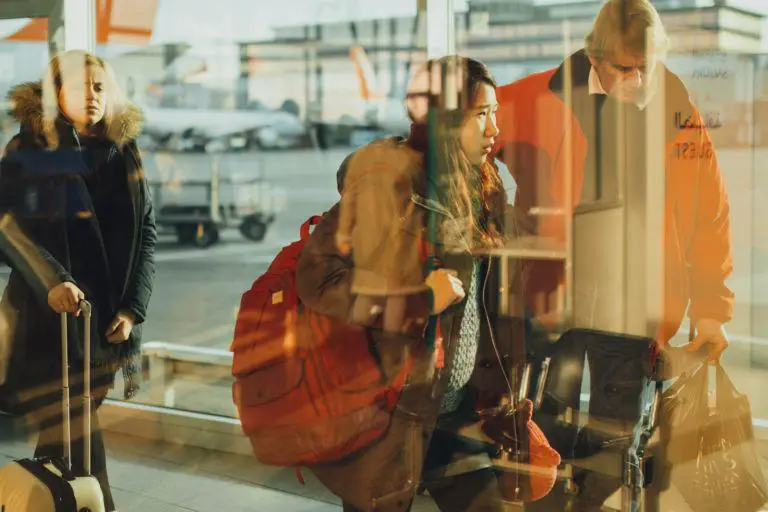
Traveler’s diarrhea happens when you get careless in your eating and drinking habits while abroad. A trip to developing countries is more likely to involve angry bowels due to lower sanitation standards. It’s generally caused by eating unsanitary water or food, hence the common knowledge to drink only bottled water. Traveler’s diarrhea can entail cramping, bloating, nausea, vomiting, and the telltale symptom of more frequent visits to the porcelain god to make donations of unusual consistencies and the unstoppable need to visit him immediately.
The Center for Disease Control says that 20 to 50 percent of travelers end up with diarrhea. Montezuma’s Revenge. The Aztec two-step. This number seems low to me, as I have gotten it in every country I have been to outside of the United States. Maybe I just have a delicate flower for a digestive tract or maybe I’m not being as careful as I think. This is a mystery I have yet to solve. In any case, just know that I feel your pain. You’ve gone through a lot of planning and expense to get to an exciting locale and nature should be calling to you in the form of white sandy beaches or snowy mountains, not in your rear end. So have fun on your latest adventure—but (or butt, HA!) take caution.
Symptoms of Traveler's Diarrhea
- More frequent bowel movements
- Loose stool and/or more of it
- Dire need to relieve yourself
- Abdominal cramping
- Bloating
- Nausea
- Vomiting
- Fever
Best Ways to Get Rid of Traveler’s Diarrhea
In planning your trip, prepare for possible medical needs while abroad.
This will vary depending on where in the world you’re headed. If you’re going to a relatively safe (read: sanitary) location, you may not need more than some Tums or Pepto Bismol just in case your stomach acts up. You can order Pepto-Bismol tablets before traveling from Amazon. Headed on a full-on jungle adventure? You might need a whole slew of vaccinations, malaria medicine, and prescription medication for possible diarrhea-related problems. Visit your primary physician or a specialist in international travel medicine to find out exactly what you’ll need to prevent the onset of this.
Now that you’re abroad, watch what you drink.
Again, this will vary depending on circumstances. I’ll take you through the most cautious route: Definitely don’t drink the tap water in developing countries. Possibly don’t even brush your teeth with it. Also skip out on ice in your drinks and fountain sodas, as they might contain the questionable water. Yes, buying bottled water is wasteful and annoying, but essential in this circumstance. You can recycle the bottles to ease your conscience.
It’s not just the water to be wary of.
Fresh produce might be washed in unsafe water, so avoid that unless you know it’s been properly cleaned. If you’re eating in nice restaurants that cater to tourists, you’re probably safe ingesting whatever is served, but that’s up to you. You’re also good to go with prepackaged foods and beverages. And even though street vendors might have food that smells great and looks delicious, eat at your own risk. I survived street food while studying in Peru, but when I told a native Peruvian, he told me that even he doesn’t eat that food. Results can vary.
You’ve got the mud butt, now what?
First things first: Stay hydrated. Dehydration is a potentially serious side effect of diarrhea. Drink lots of water, Gatorade, or Pedialyte-type beverages to replenish what your body is losing out of your derriere. There’s a recipe for a homemade version of this stuff in the sidebar if you don’t have access to the former two options. Staying hydrated will also help flush out your system to get rid of whatever is making you sick.
Take whatever meds you brought along or find some.
Your bout of diarrhea will run its course eventually, but medication can help relieve the effects so you can still enjoy your trip. Over-the-counter Pepto-Bismol or Imodium A-D can calm your tummy. If your doctor prescribed prescription-strength stuff, take it now. Beware of side effects. Some might tell you to avoid direct sunlight, which I learned the hard way once. It’s not a great feeling, either, so plan activities accordingly.
Natural Remedies
Homemade sports drink. Mix a half teaspoon of salt and six teaspoons of sugar into a liter of clean water. It may not taste as good as pre-bottled versions, but it’ll give you what you need.
Chamomile tea. This tasty tea can help calm your stomach, keep you hydrated, and also make you mildly sleepy to help you rest—all things a sick body can use. We’d recommend Tazo Calm Chamomile, which you can get at Amazon.
Blueberries. Fruit is always good for you, but blueberries are good at calming down diarrhea and are full of healthy antioxidants.
When to Seek Professional Treatment
It’s not often that a case of traveler’s diarrhea will turn into a medical emergency—but it happens. Most of the time you’ll be better within a day or two, even if it’s not a fun time while you wait. If you can’t shake your symptoms within a few days, or if you have severe symptoms (bloody stool, dehydration, high fever, uncharacteristic drowsiness, etc.), seek medical attention. It means you have something more dangerous going on inside of you than just an upset stomach. Usually it’s E. coli (Escherichia coli), but in serious cases it’s a more potent form of bacteria or possibly a parasite of some sort. If you have children expressing symptoms, watch them. They’re more sensitive. If you’re still abroad and need care, just think of it as a new adventure to tell your friends about, especially if you don’t speak the local language. Now you just get to see one more aspect of the culture you’re visiting—the local health-care system.